Media | Articles
Chevy Cosworth Vega: The BMW-fighter that wasn’t
Does anyone remember the Chevrolet Cosworth Vega? A remarkable little car with an interesting story, and a machine that never quite met the promise of its name. Hyped from birth as an import-fighter, the car the media dubbed “CosVeg” lived for just two model years, 1975 and 1976. It could have been so much more.
Available in a host of body styles—two-door hatchback, notchback, wagon and sedan delivery—Chevy’s rear-drive Vega subcompact arrived in dealerships in September of 1970. Motor Trend named it the 1971 “Car of the Year.” Four and a half years later, the limited-production Cosworth Vega performance model hit showrooms. The 2.3-liter, aluminum-block four found in base Vegas was gone, replaced by a 2.0-liter version of the same engine. The key difference lived up top, under a stylish black valve cover: a 16-valve, twin-cam head designed by Formula 1 supplier Cosworth Engineering.

The idea was hatched in 1969. Envisioning 2.0-liter racing championships on both sides of the Atlantic, Chevrolet general manager John DeLorean convinced Cosworth’s Keith Duckworth to develop an all-out racing version of the Vega engine. The first prototype was dyno-tested in March of 1971. The engine proved capable of as much as 290 hp, but it also proved unreliable. The racing effort died.
Back in the States, Vega sales were weak. The available GT model looked nice enough but lacked the image or performance to much help the Vega’s volume. DeLorean and his assistant chief engineer, Lloyd Reuss, proposed a hot Vega powered by a reliable street version of the Cosworth racing engine. With enough power under the hood, they felt, the car could take on the sporting European sedans of the day—machines like the BMW 2002tii and the Alfa Romeo GTV.

Handling dynamics were seen as a Vega GT strong point, so the Cosworth version saw few suspension changes. The GT’s quick, 16:1-ratio steering box carried over. The GT’s front and rear sway bar sizes were adjusted to reduce understeer. On top of that, the Vega’s solid rear axle gained limiting cables to reduce acceleration hop, and the standard four-speed manual received a shorter, 3.7:1 first gear.
Marketplace
Buy and sell classics with confidence
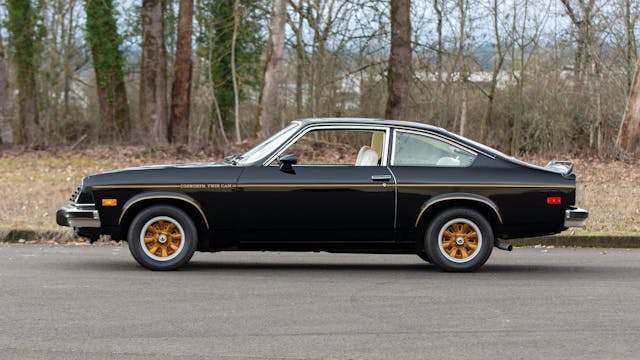
PR can make you, and PR can break you
In August of 1973, a GM press release announced the car. Car and Driver read that release and turned on the hyperbole: “A taut-muscled GT coupe,” the magazine said, “to devastate the smugness of BMW 2002tii’s and five-speed Alfa GTVs. A limited run of 4000 machines, each one built away from the tumult of the assembly line to precision tolerances, as a show of technical force by Chevrolet. All of them will be collector’s items.”
Then came a November 1973 media drive of prototypes at GM’s main proving grounds, in Milford, Michigan. That event produced multiple stories, including one by your author.
In the December 1, 1973 issue of Competition Press and Autoweek, we wrote:
“Accelerating the CosVeg through the smooth Chevy four-speed is an exhilarating experience indeed. It is not a low-end torquer, as you might expect, and getting it off the line in a hurry requires some fancy footwork, high revs, and abundant radial-tire smoke. But once it’s off, it’s off! Zero-to-60 times are consistently under 9 seconds, and quarter-mile times are in the neighborhood of 17 seconds, using the normal 7000-rpm redline.”
With Chevy development engineer Warren Frank in the passenger seat, we flogged the car around Milford’s challenging “Ride and Handling” loop:
“There, it performs admirably, with the only fault being a tricky bump-steer condition, which causes it to lose, momentarily, its remarkably stable and neutral cornering attitude [on] washboard roads. Frank explained that they were still working on shock rates to remedy this, and to keep the wheels on the ground for a larger percentage of the time . . .”
Then we drove a few hard laps around Milford’s road-course-like “Seven Sisters,” a series of four tightly banked turns followed by three faster flat ones:
“…which quickly revealed the CosVeg’s other glaring deficiency in its present state. Unaccountably, Chevrolet has not seen fit to give it a limited-slip differential. The Vega GT suspension, which is otherwise nearly flawless, is just not stiff enough to prevent the car from lifting its inside leg like an impolite dog on the hard, tight turns.
This results in massive wheelspin as all the CosVeg’s considerable power is transferred to the unloaded side, and the car skids helplessly sideways . . . Then the inside tire falls from the sky, finally recovers its bite, and off you go toward a repeat performance on the next turn. This behavior is barely acceptable in a below-average econobox . . . inexcusable in a car of this nature.”
I respectfully suggested that they equip production CosVegs with limited-slips. Frank said he would see what he could do.

The Cossie: Hand-built and high-rpm
The Vega’s aluminum block saw Cosworth duty with relatively few changes. Its stroke was decreased, to give the desirable (for racing, remember) 2.0-liter displacement. That 16-valve, twin-cam, crossflow, aluminum Cosworth head was mated to Bendix electronic fuel-injection. (The CosVeg was the first GM passenger car to use electronic injection.) Thanks partly to an aluminum camshaft housing and an aluminum intake manifold, the engine scaled in at 40 pounds lighter than the 2.3 in the base Vega.
The forged steel crankshaft was chemically “tuftrided,” to harden its bearing surfaces for added durabilty. The pistons were forged aluminum with cutouts for valve clearance. Their large sumps gave the low 8.5:1 compression ratio required for emissions and CAFE compliance, but on the bright side, that conservative spec enabled the stock CosVeg to run well on regular low-lead gas. GM claimed that the development car we tested in 1973 easily met that year’s emission standards without the help of any common “add-ons”—no air pump, no exhaust-gas recirculation (EGR) system, and no carburetor-hot-air (CHA) system.
The bad news? That low compression ratio yielded truly meager output. The engine was originally planned for 12:1 compression, which would have required premium fuel. Emissions-related pullbacks during development saw that figure fall to 10.5:1, then 9.5, then 8.5. Power fell from the originally projected 185 hp to 135, and then, finally, to the production rating of 110 hp, SAE net.
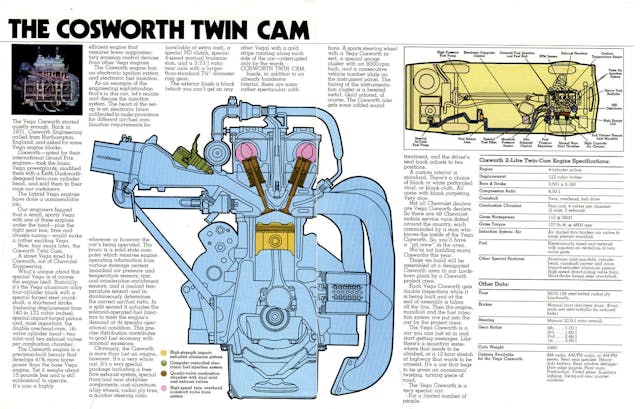
The engines were built by hand at GM’s Tonawanda engine plant in New York, then shipped to the Vega plant in Lordstown, Ohio, where they were carefully installed into cars off to the side of the regular Vega assembly line. Chevrolet announced that Cosworth Vegas would be assembled at a very slow rate at first, to ensure quality control, with production eventually increasing to one car per hour. Buyers, GM said, would get an exclusive toll-free phone number for reaching the factory, and they would receive special attention should anything go wrong.
Just 5000 CosVegs were scheduled to be built that first year. Not coincidentally, this was the minimum number required for homologation for production-based FIA Group 1 “touring car” racing.
Naturally, the government then took another bite. The EPA did not issue the Cosworth Vega a certificate of emissions compliance until March 14 of 1975. Production began immediately after, as Chevrolet rushed to fill the order backlog generated by positive press.
All 1975 CosVegs were black with gold trim. The car’s lightly flared wheel arches were accentuated by gold pinstriping, and a similar stripe swept from headlamps to taillamps, interrupted just forward of the doors by “Cosworth Twin Cam” in gold script. Inside, the standard Vega GT gauge package was framed by a machine-turned aluminum dash tinted gold.

Two cams, two years
The “clean room” assembly area at the Tonawanda plant was originally created for Chevrolet’s aluminum-block, 427-cube ZL-1 V-8. From that space came some 30 Cosworth Vega engines per day. The Lordstown side line could assemble just 1.6 Cosworth Vegas per hour—the regular Vega clocked in at 60 or more. All told, just 2061 CosVegs were built for the 1975 model year.

All that emissions detuning paid dividends: No other General Motors passenger car was emissions-certified for all 50 states. Car and Driver would later announce, in a “History of 0–60” feature story, that a preproduction ’74 Cosworth Vega hit 60 mph in only 7.7 seconds, the fastest time recorded by the magazine for 1975. And while the final production ratings were disappointing—110 hp at 5600 rpm, 107 lb-ft at 4800—after testing a 1975 production model, C/D added, “The outstanding feature of the Cosworth Vega is its excellent balance. Roll-stiffness distribution is ideal, with little understeer entering a turn and just the right amount of drift from the tail as you put your foot down to exit.”
A 1976 facelift brought a wider grill, tri-color taillamps, and extensive improvements in rustproofing. The exhaust system replaced the dual outlets used in 1975 with a single tailpipe, and the base seat trim was changed to grained vinyl. The optional cloth seat inserts were updated to a houndstooth “sport-cloth.” A new Borg-Warner five-speed manual overdrive transmission was made available, paired to a 4.10:1 rear axle. A “Sky-Roof” with tinted and reflective sliding glass could now be had, along with an eight-track tape player, eight new paint shades, and two new interior colors.
All to no avail. In November of 1975, GM decided to kill the car after the ’76 model year. (Volume production for ’76 began in December.) Road & Track reported the CosVeg’s handling as “very good” after testing a 1976 model. Road Test’s 1976 “Super-Coupe Shootout — Alfa vs. Mazda vs. Lancia vs. Saab vs. Cosworth Vega” said,
“Right there at the top, and by a long way . . . is the Cosworth Vega. It had the fastest 0–60 time, the fastest quarter-mile time, and [it] tied with the Saab for the shortest braking distance . . . The Cosworth is American, and a collector’s item, and it came close, damn close, to winning the whole thing.”
If the CosVeg had been as good as promised, if it had been offered at the rumored $4000 price, the story might have been different. Early on, many thought the Chevy would be sold out before the first example hit showrooms. Pricing changes didn’t help. During the seven-year lifespan of the base Vega, inflation and the rising cost of government certification helped bump prices of all new automobiles sold in America by 50 percent. The 1975 CosVeg stickered at $5918, nearly double the cost of that year’s entry-level Vega and less than $900 below the 1975 Corvette.

There was also the car beneath the engine. The Vega itself had grown notorious several issues, from reliability to safety, rust-through, and engine durability. Despite a series of recalls and design upgrades, those problems tarnished the reputation of both the model and its maker.
Just 1447 CosVegs were built for 1976. Combined with the ’75 model year, just 3508 examples of the car were sold. As for those 5000 engines? GM took the leftovers, disassembled 500 of them, then scrapped the remainder. Regular Vega production ended following the 1977 model year.
Two cars, one good-looking Cosworth valve cover, and a lot of unrealized potential. General Motors was troubled in the mid-1970s, and the Vega was part of those wounds. The Cossie version at least had the ingredients for a healing salve. Time will tell if the model’s rarity and that potential is enough to vindicate those CosVeg owners who still carry the torch. In the meantime, we can think about what might have been, and we can dream.

For more info, visit the Cosworth Vega Owners’ Association (CVOA): cosworthvega.com.
Check out the Hagerty Media homepage so you don’t miss a single story, or better yet, bookmark it.









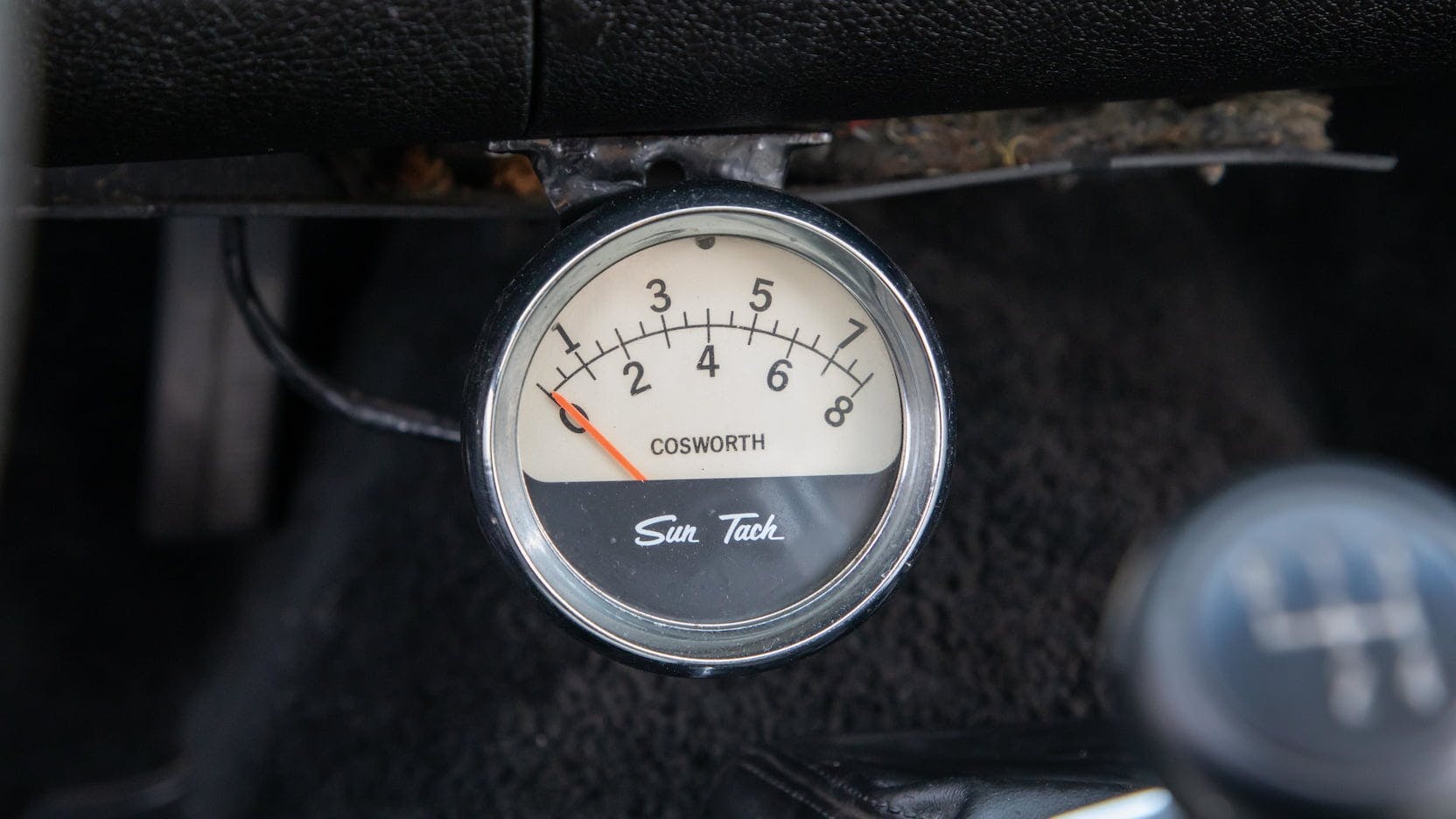
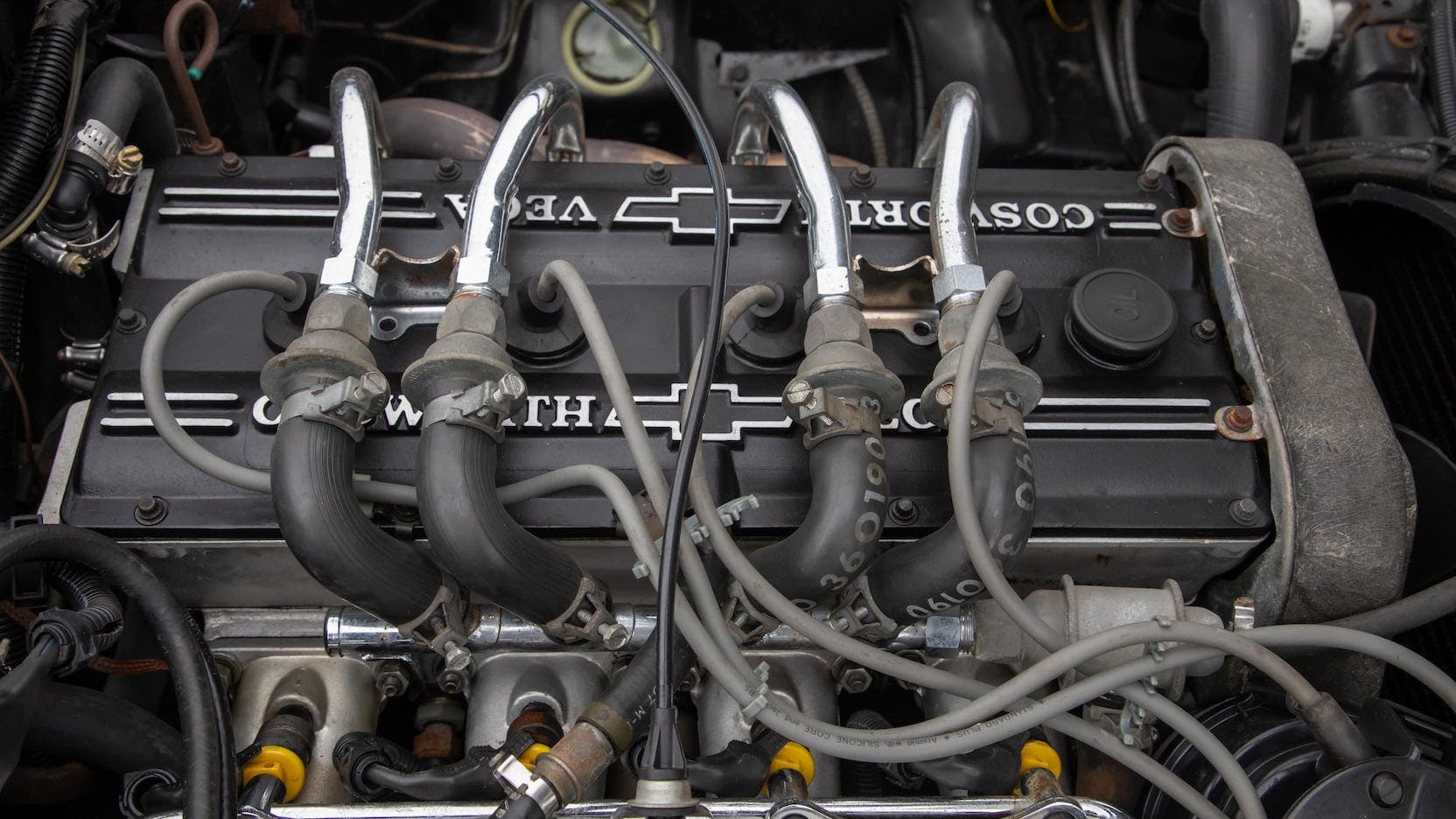
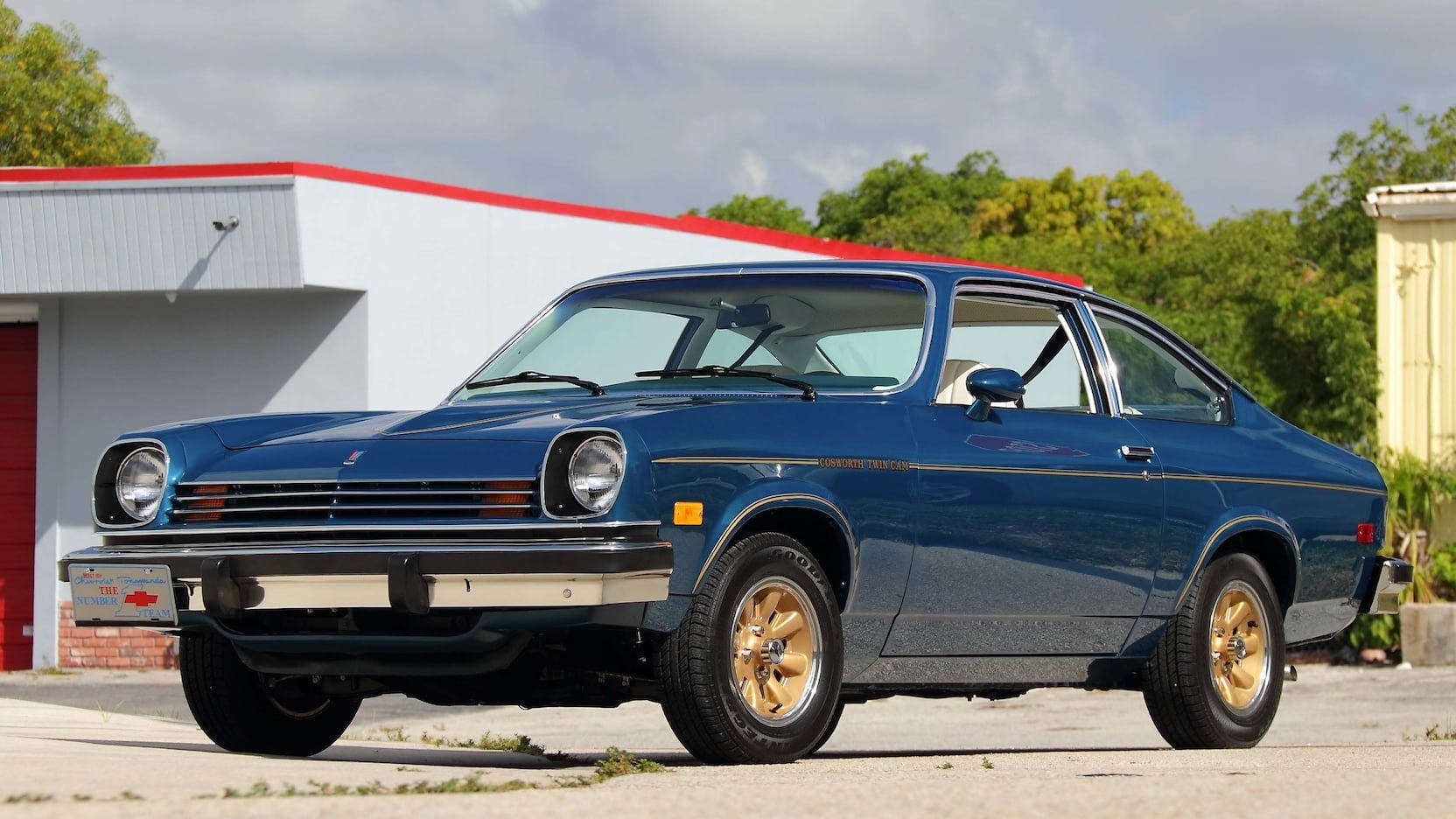
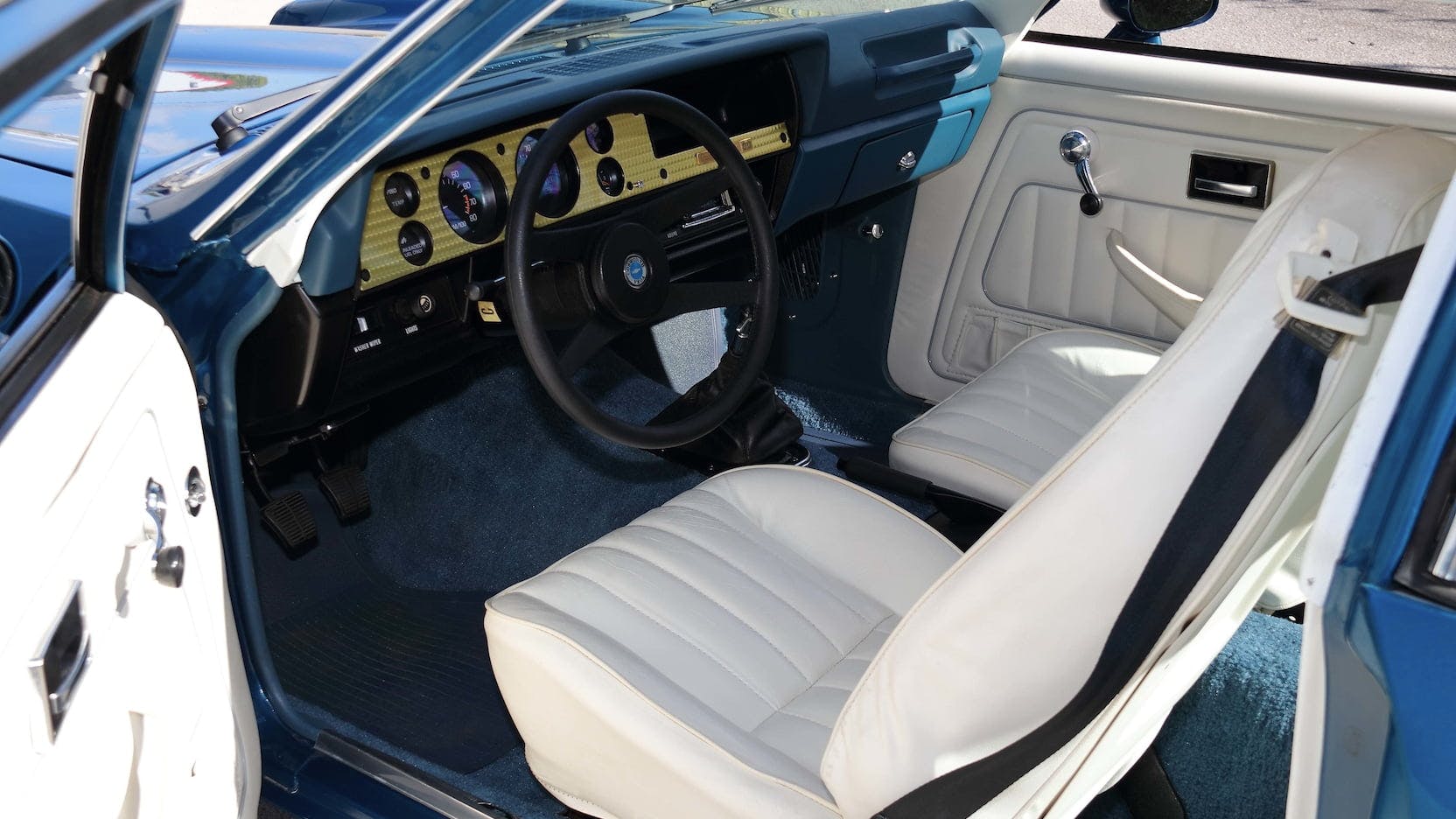












My first new car was a 76 Cosworth Vega. I was 18, almost 19 so, kind of young and dumb. My dad hated that car because he thought I could have got more for the money. The dealership had discounted it from 6900 to 6200 so it seemed like a deal at the time.
Other than the price, I could not really complain about it. I had it for 3 and half years, and had very few problems with it. It did sit in the shop at Luby Chevrolet for 3 weeks due to a computer problem. There was only 1 mechanic in the Denver metro area under Chevy’s employment that knew how to work on them.
He had to wait on the diagnostic equipment needed before he could get started. He had 5 other Cosworths to work on for the same or similar issue. He told me that mine was in the best condition so it stayed in the shop with the testing equipment. Kind of a complement but another reason why it sat there for 3 weeks. The $500 bill in 1979 kind of sucked too.
It was number 2285. It came with the 5 speed Borg Warner T-50 that was paired with the 410 limited slip rear end. Standard black and gold trim with the white interior. The T-50 was kind of fragile. One of the synchros got chewed up between the 3rd and 4th gears so I had to learn how to double clutch.
My first car was a 71 Vega 2300. It too had 110HP and was 600 pounds lighter than the Cosworth but that car, although fun to drive, would never be able to keep up with the Cosworth.
My 2nd car was a 69 Dodge Charger RT with a 440 magnum. That car was fun but in the year that owned it, it wiped out my savings and I almost lost my license. It was a cop magnet.
The Cosworth didn’t attract that kind of attention so it was so much more fun to drive. Sure, it didn’t have that spine crushing acceleration that the Charger had but it got more than 10 miles to the gallon and I could use regular unleaded gas.
Once I figured out how to corner with it, I had lots of fun driving in the mountains.
I wish I would have kept it.
There is an excellent example of a Cosworth Vega in the collection of the Antique Automobile Club of America Museum. It is probably one of my top five cars that they have there.
Really Gary? You don’t think the 1976 Cosworth compares to the 1976 BMW 2002? First of all the 2002 was down to 98-hp in 1976. Price wise the 76 2002 was $500. more the 76 Cosworth. In 75 they were the same price. 1976 Cosworth Vega $6,066 | 1976 BMW 2002 $6,570.
Next let’s see what Car & Driver had to say.
“The Cosworth Vega is meant for driving, not showing off.” “The Cosworth Vega will please its owner by virtue of its efficiency and sophistication.” “The Cosworth Vega is closer to an uncompromised GT car than anything Detroit has ever built.”
“The car was to be an image builder, a little something to show the world that Chevrolet Engineering could knock BMW off with its left hand if it wanted to.”
“Z09 Cosworth Vega is a direct derivative of the EA racing engine. Although it will probably be widely thought of as a souped up Vega engine, it is in truth a de-tuned EA racing engine..”
“The Cosworth Vega 16-valve four cylinder is the most sophisticated engine Detroit ever made.”
“Through the woods or down a mountain, the Cosworth is a feisty aggressor willing, if not altogether able to take on the world’s best GT cars.”
You need to do a bit more research ( I don’t mean online)
Car and Driver clocked the Cosworth Vega at 0-60 in 8.7 sec top speed of 107 mph, Any car meeting 1975 emission standards with 0-60 under 10 seconds was considered fast. The ’75 Cosworth Vega was tested faster than the 155-hp 140 cu. in Yenko Stinger II turbo (9.0 sec), the 245-hp 454 cu in ’74 Chevelle S-3 (10.5 sec) and faster than its four cylinder foreign competition including the 98-hp, 122 cu in ’75 BMW 2002 (10.7 sec) at the same MSRP
The 75 2002tii with 130-hp 0-60 8.3 sec. The 75 Cosworth with 110-hp 0-60 in 8.7 sec. The BMW fighter that was.
The 75 2002tii with 130-hp 0-60 8.3 sec. The 75 Cosworth with 110-hp 0-60 in 8.7 sec. The BMW fighter that was.
The ’75 Cosworth Vega was tested faster than its four cylinder foreign competition including the 98-hp, 122 cu in ’75 BMW 2002 (10.7 sec). The 75 2002tii with (130-hp) 0-60 8.3 sec. The 75 Cosworth with (110-hp) 0-60 in 8.7 sec. and without the catalytic converter C&D tested the Cosworth pilot (130-hp) at 0-60 in 7.7 seconds. The BMW fighter that was.
Car and Driver named it Car of the Year because GM sucked up to them with promises of advertising revenue for Petersen Publishing. The award had more to do with the publisher’s bottom line and GM’s desire to reap sales from such an award read by Car and Driver’s many purchasers (said award plastered all over Chevy dealer’s showrooms). The car is actually considered to be one of the worst ever from The Big Three.
I realize the article is more about the Cosworth variant, but it references the Car of the Year award, which helped entice me to make a 1972 Vega my first new car purchase. One engine block, one transmission, one rear-end, and a host of other problems later, I vowed never to own another GM product, and I’ve kept that vow.
My 50 year old Vega still has its original powertrain. Some people just have bad luck. 2 million were built and the majority had good luck especially if they checked the fluid levels often enough.